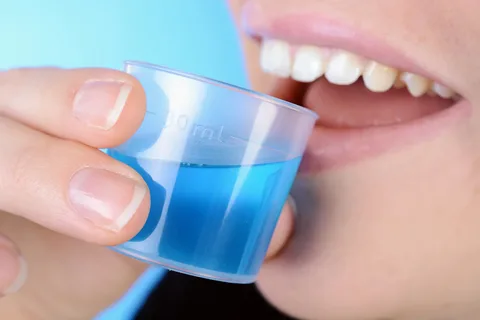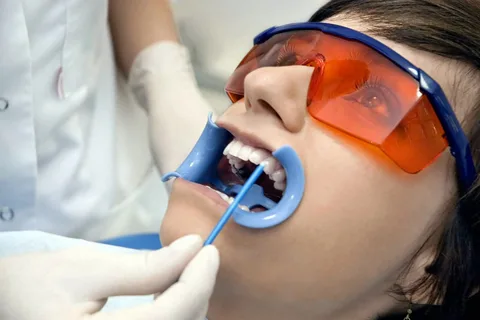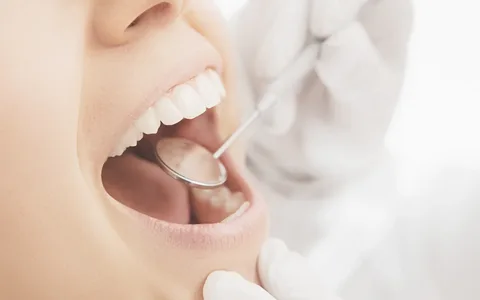Fluoride in dentistry
Machine translation
Original article is written in articles.localeLanguage (link to read it) .
Scientists have been researching the effectiveness of fluoride use for a long period of time, having accumulated extensive practical and scientific experience, and assessing not only the immediate, but also the long-term results of using fluoride in the prevention of caries.
Learn more about fluoride prevention of caries at the webinar Caries: diagnosis, risk assessment, non-invasive and minimally invasive treatment in pediatric dentistry .
Over the past 60-70 years, fluorides have rightfully been considered the main drug for the prevention of caries. There are several methods of using fluoride:
systemic,
local.
Locals suggest the use of fluoride-containing preparations as applications directly to the teeth. Systemic ones provide for the intake of additional fluoride ions into the body to protect dental tissues from carious destruction among patients of all age groups.

Figure 1. Fluoride toothpaste.
Prevalence
By the beginning of the 21st century, prophylactic drugs and products enriched with fluorides were quite widespread in the world.
Thus, about 230 million people consume fluoridated water, about 0.5 billion people use fluoridated pastes daily, and 400 million people use fluoridated salt.
The attitude of specialists towards fluoride prophylaxis is ambiguous; the very idea of using an additional source of fluoride ions daily, as well as the methods for implementing this program, have both supporters and opponents. And not only at the level of individual consumers, but even among communities of doctors and at the level of entire countries.
Despite significant changes throughout the world in the prevalence of dental caries among the population, caries problems persist, mainly affecting low-income categories of people not only in developing but also in developed countries.
Studies conducted in several countries have confirmed the effectiveness of caries prevention programs. Fluoridation of milk, salt, water, and the use of inexpensive fluoridated toothpastes are all of critical importance in public health.

Figure 2. Mouthwash.
The effectiveness of endogenous fluoride prophylaxis has been clinically proven, which leads to a significant decrease in the hygiene index, as well as a decrease in the intensity of caries.
In many countries of the world, despite the introduction of fluoride prophylaxis, there has not been such a unique drop in dental morbidity as occurs in the USA and some Western European countries.
The use of fluoridated water in the United States is the most popular supplemental source of fluoride ions, but it also has its drawbacks. Initial forms of fluorosis occur in about a third of 9-year-old children and in about 20% of adolescents. However, moderate and severe forms are rare, accounting for less than 1% of cases.
Prevention of fluorosis
The unique anti-caries and remineralizing effect of fluoride ions has been proven in numerous clinical trials. But in an effort to achieve maximum effect, do not forget about safety.
It is important to find out the concentration of fluoride ions in drinking water in the region: if the indicators are below optimal, the introduction of fluoride-containing additives is possible and necessary, but if the fluoride content is 2 ppm or more, then the following steps should be taken:
Children should be encouraged to drink water from alternative sources;
For children under 6 years of age, use fluoride-containing toothpastes in quantities not exceeding the size of a pea to brush their teeth twice a day;
refuse an additional source of fluoride ions (fluoride-containing rinses, for example) without first consulting a dentist.
Using fluoridated salt
Salt fluoridation is an excellent alternative for local residents of regions where a minimum concentration of fluoride in water is established and there is no way to provide the population with fluoridated water.
The results of the salt fluoridation program showed an increase in children's nonspecific oral resistance and the proportion of secretory immunoglobulins. The resistance of the body as a whole also increases, which is manifested in an established drop in the level of infectious morbidity and a decrease in the duration of the disease.

Figure 3. Application of fluoride varnish.
In many countries, salt fluoridation is an alternative to water fluoridation. Only one of these programs can be used.
One of the first salt fluoridation programs began in Switzerland, back in 1955, but adoption of fluoridated salt for home use was slow. Some of the medical community preferred the use of fluoridated water, while others considered the concentration of fluoride in the salt to be insufficient (90 ppm). It was not until 1983 that the use of fluoridated salt gained acceptance in Switzerland, when the fluoride concentration was increased to 250 ppm.
Salt fluoridation is the cheapest way to prevent caries; billions of people use this method. To date, programs for the use of fluoridated salt are being implemented in Cambodia, Laos, and Madagascar.
The obvious advantages of using salt as a means of transporting fluoride significantly outweigh the disadvantages of this method. Namely:
variability in food consumption,
difficulty maintaining optimal concentration,
presence of hypertension.
Given the risk of excessive fluoride intake, the use of both water and salt fluoridation is not recommended. Countries where both of these programs operate have high rates of fluorosis.
Fluoride toothpastes
One of the options for the entry of fluoride into the surface structures of the enamel to increase the caries resistance of the latter is the use of fluoride-containing toothpastes for daily brushing of teeth. Today, such pastes are the main source of fluoride in the world.

Figure 4. Fluoride is the basis for caries prevention.
Children's toothpastes contain all kinds of therapeutic and prophylactic components:
enzymes,
xylitol,
calcium compounds,
herbal extracts,
fluorides.
All of these supplements are designed to help reduce the amount of plaque and increase the mineralization of tooth enamel. But in the course of clinical studies, only the role of fluoridated toothpastes in the prevention of caries was confirmed.
Numerous studies have made it possible to prove the caries-preventative effectiveness of fluoride-containing toothpastes, so the relevance of further studying the value of these drugs for oral hygiene and caries prevention is undeniable.
Using toothpastes containing the optimal amount of fluoride daily allows you to:
significantly increase the resistance of hard dental tissues,
reduce enamel permeability,
reduce the solubility of enamel,
dramatically reduce the intensity of caries.
Toothpastes containing fluorides have a strengthening effect on the mineral component of tooth tissues and serve as a preventative against the formation of plaque. The highest anti-carious effect of fluoride and pastes that contain it is observed in childhood during the maturation of enamel. With age, the anti-caries effectiveness of pastes containing fluorides decreases significantly. In this regard, fluoride-containing toothpastes should be used primarily for children as a preventive measure for dental caries.
Additional means of prevention
To prevent caries, in addition to using fluoride orally with water and salt, it is recommended to use local applications of fluoride-containing preparations: solutions, gels, varnishes.

Figure 5. Use of fluoridated water.
Fluorine-containing varnish is a mixture of natural resins that contain up to 5% fluorine. Gradually drying, the varnish leaves a transparent film that remains on the teeth for several hours, including such hard-to-reach areas as fissures, pits and microspaces, where microfilm residues remain for days and weeks.
Studies have shown that varnishes mainly prevented the formation of new cavities on occlusal surfaces, but in case of long-term use they also had a protective effect on smooth tooth surfaces.
There is another highly effective method of caries prevention, the so-called “deep fluoridation”. It is based on the use of enamel and dentin sealing liquids.
Enamel-sealing liquid serves to prevent the development of carious defects in the surface layers of hard tissues. Dentin-sealing liquid serves to prevent demineralization of tooth tissue located under restoration or orthopedic construction.
More relevant information on caries prevention at the webinar Minimally invasive dentistry and bioactive materials in the treatment of caries and molar-incisal hypomineralization .

/public-service/media/default/168/OJhGc_65311d2b71512.jpg)
/public-service/media/default/174/3jNvq_65311fa9e8fa0.jpg)
/public-service/media/default/507/XVjr3_671f5ca5a4d2d.jpg)
/public-service/media/default/169/oVhio_65311d417b778.jpg)